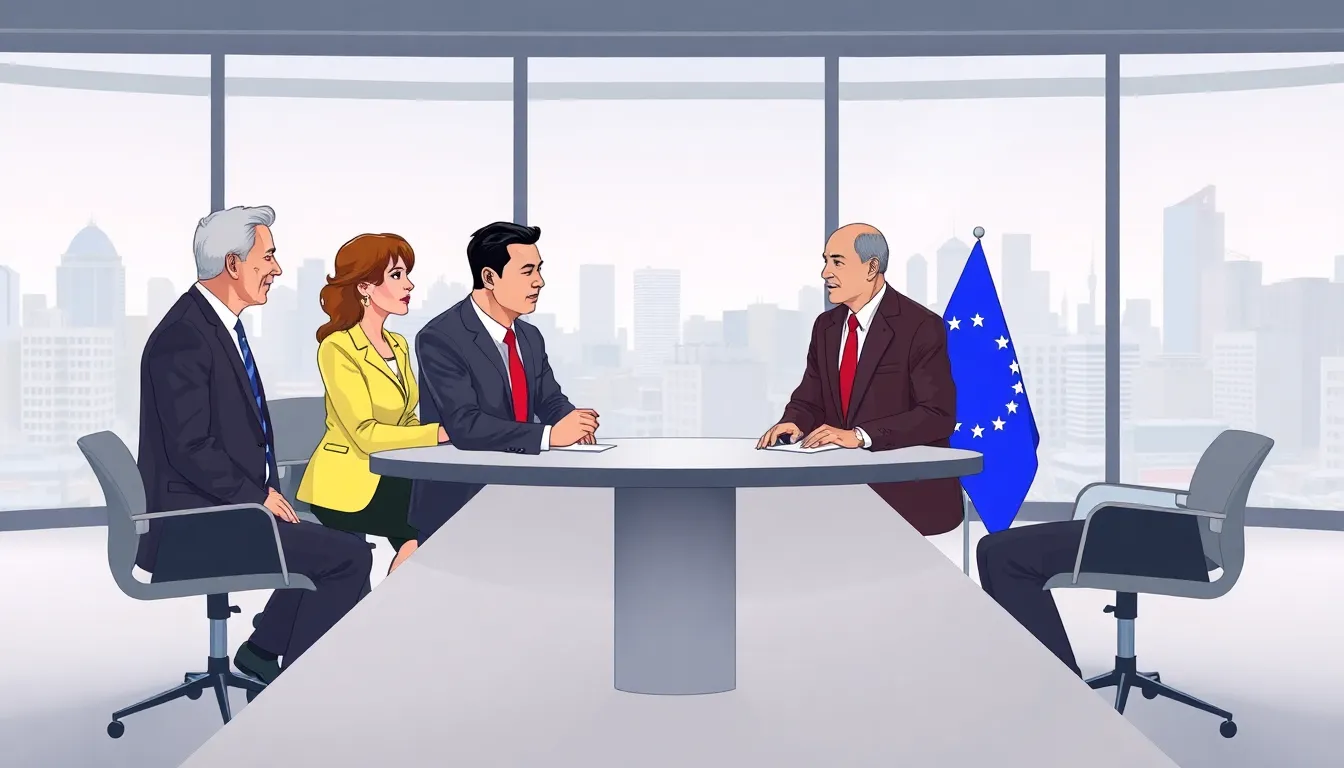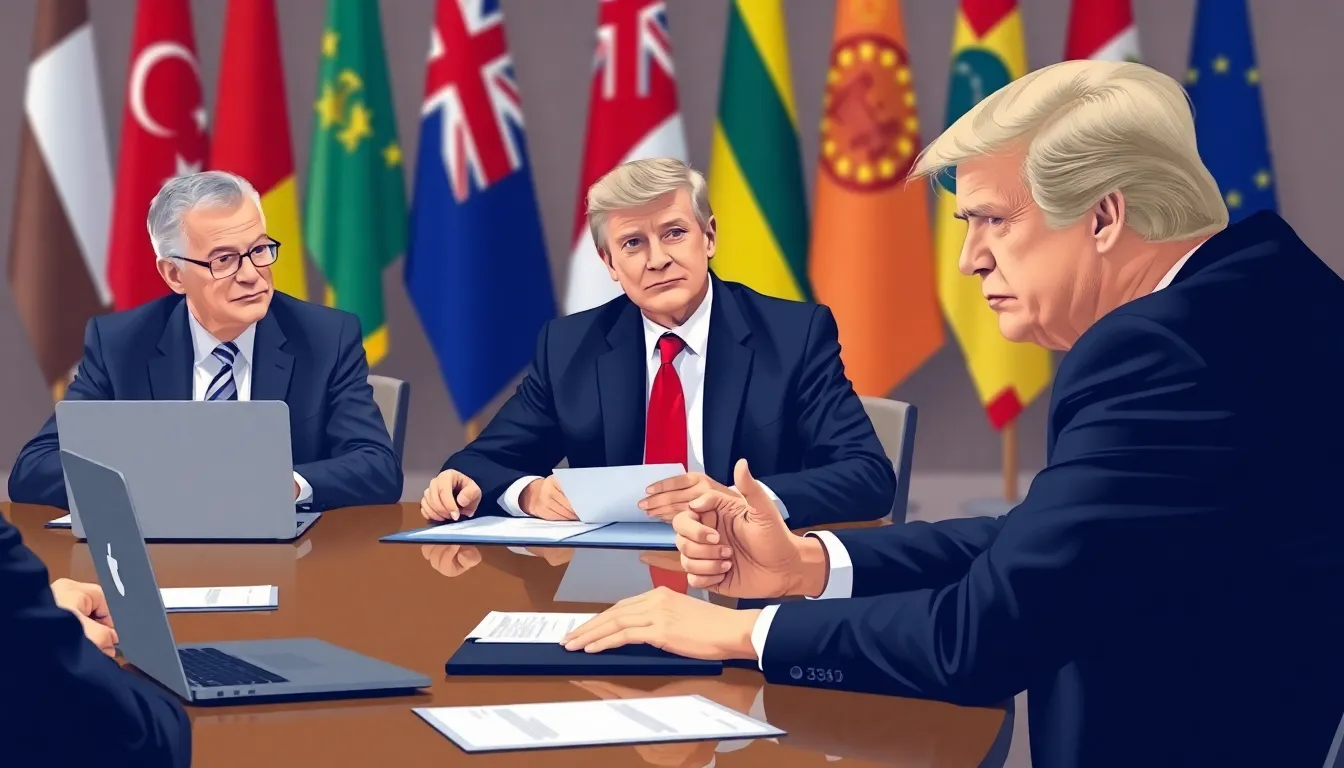Table of Contents
ToggleIn a world where trade wars can feel like a game of poker, countries are shuffling their cards and eyeing each other’s chips. Tariffs, those pesky taxes on imports, are back in the spotlight as nations negotiate deals that could change the global marketplace. It’s like a high-stakes dance-off, and everyone’s trying to avoid stepping on toes while aiming for the best deal.
Overview of Tariff Negotiations
Countries engage in tariff negotiations to influence trade dynamics and economic growth. Strategic discussions frequently occur between the United States and China, as both aim to enhance market access and protect domestic industries. Trade agreements often address tariffs, shaping policies that affect various sectors.
India participates actively in negotiations with multiple countries, such as Japan and Australia, focusing on reducing trade barriers. European Union members also engage in discussions to harmonize tariffs within their market while negotiating deals with non-member states. Mexico seeks to collaborate with Canada and the U.S. through the United States-Mexico-Canada Agreement (USMCA), aiming for favorable tariff structures.
Brazil stands out by negotiating tariffs within regional blocs like Mercosur, promoting trade with South American nations and beyond. ASEAN countries collaborate to lower tariffs among members while negotiating trade agreements with larger economies. These efforts seek mutual benefits while addressing challenges such as trade imbalances.
Throughout these negotiations, the importance of market access is paramount. Countries strive to balance competitiveness with domestic concerns, creating an intricate landscape of international trade. Current discussions reflect ongoing trends, highlighting a push for fairer terms across various industries and sectors.
Key Countries Involved in Negotiations

Countries are actively engaged in tariff negotiations, reflecting their interests in enhancing trade dynamics. The major players include the United States, China, the European Union, and India.
Country 1: United States
The United States is central to many ongoing tariff negotiations, focusing on market access and regulatory issues. Ongoing discussions mainly occur with China, aiming to address trade imbalances and intellectual property concerns. The U.S. also works within the framework of the United States-Mexico-Canada Agreement (USMCA), seeking to strengthen economic ties in North America. Additionally, ongoing trade talks with the European Union target mutually beneficial tariffs on goods and services.
Country 2: China
China plays a crucial role in global tariff negotiations, actively engaging with various nations to enhance its trade foothold. The country’s primary focus is on the United States, with both nations addressing tariffs and market accessibility. Efforts also extend to trade discussions with the European Union, particularly in technology and investment sectors. China seeks to fortify ties with emerging markets, recognizing the importance of diverse trading partners in a dynamic economic landscape.
Country 3: European Union
The European Union comprises multiple member states engaged in harmonizing tariffs within its market. Focused on maintaining competitive trade levels, the EU negotiates with significant partners like the United States and China. Ongoing discussions seek to resolve long-standing trade disputes while ensuring fair conditions. The EU is also exploring tariff reductions with non-member states, strengthening its global trade networks and promoting economic growth across Europe.
Country 4: India
India is actively negotiating tariffs with key nations, including Japan and Australia, to lower trade barriers. These efforts aim to promote bilateral trade and enhance economic cooperation. India’s initiatives are part of a broader strategy to integrate more fully into regional and global supply chains. Ongoing talks reflect India’s commitment to balancing domestic interests while expanding its trade presence on the world stage.
Recent Developments in Tariff Negotiations
Countries continue to engage in active dialogues to reshape global trade dynamics. Negotiations often hinge on tariffs, affecting various industries and international relations.
Trade Agreements and Discussions
Trade agreements play a crucial role in tariff negotiations. The United States and China remain at the forefront, focusing on issues like market access and mutual tariff reductions. India engages Japan and Australia, targeting lower trade barriers that facilitate smoother transactions. The European Union also emphasizes harmonizing internal tariffs while addressing disputes with significant trading partners. Collaborative frameworks like the United States-Mexico-Canada Agreement (USMCA) highlight the interdependence among North American countries, encouraging trade without excessive tariffs. Notably, Brazil pursues intra-regional strategies within Mercosur, aiming to boost trade while maintaining competitive advantages.
Impact of Current Events on Negotiations
Current global events significantly influence tariff negotiations. Economic uncertainty caused by geopolitical tensions leads nations to reassess their positions and strategies. The COVID-19 pandemic has reshaped supply chains, prompting countries to negotiate less rigid tariffs and focus on resilience. China’s engagement with the European Union centers around technology investments, reflecting the growing importance of digital trade. Instability in energy markets also motivates nations to negotiate tariffs that stabilize their economies. As countries react to these developments, shifts in trade policies emerge, affecting their long-term economic prospects.
Economic Implications of Tariff Changes
Tariff changes lead to significant economic consequences on both domestic and global levels. They can directly influence prices for consumers and businesses alike. When countries impose higher tariffs, imported goods often become more expensive, impacting consumer spending patterns.
Many industries feel the effects of tariff negotiations as companies reassess their supply chains. Adjustments to tariffs can alter sourcing decisions, prompting manufacturers to look for alternative markets. For example, if the U.S. raises tariffs on Chinese imports, businesses might shift sourcing to other countries like Vietnam or Mexico.
Trade relations between countries hinge on tariff discussions. For instance, the European Union’s efforts to harmonize tariffs can facilitate trade among its member states, while delineating clear terms with non-member countries. Negotiations between India, Japan, and Australia aim to lower trade barriers, promoting more robust economic integration.
Negotiators must also consider retaliation from other nations when altering tariffs. A country’s decision to impose tariffs can provoke similar actions from its trading partners, potentially escalating tensions and leading to trade disputes. Such retaliatory measures can disrupt market stability, making long-term planning increasingly difficult.
Market access remains a central focus in tariff negotiations. Countries that successfully negotiate lower tariffs often gain competitive advantages, especially in technology and agricultural sectors. These developments highlight the need for continuous engagement and dialogue to balance interests while promoting fair trade.
Economic uncertainty, exacerbated by events like geopolitical conflicts and pandemics, further complicates tariff discussions. Resilience in supply chains becomes a priority as nations aim to mitigate risks associated with dependence on specific markets. The ongoing adjustments in global trade reflect changing priorities, shaping future economic landscapes.
The landscape of international trade is continually evolving as countries navigate complex tariff negotiations. These discussions are crucial for shaping economic relationships and influencing market dynamics. As nations strive for favorable agreements, the implications of their decisions resonate across industries and consumers alike.
With major players like the United States and China leading the charge, the outcome of these negotiations will have far-reaching effects. Countries like India, Brazil, and members of the European Union are also playing vital roles in redefining trade barriers. The ongoing dialogues reflect a commitment to finding a balance between competitive advantages and collaborative efforts.
As nations adapt to changing global conditions, the importance of strategic tariff negotiations will only grow, highlighting the need for continued engagement in the international arena.




